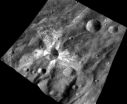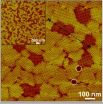(Press-News.org) By decoding the genomes of more than 1,000 people whose homelands stretch from Africa and Asia to Europe and the Americas, scientists have compiled the largest and most detailed catalog yet of human genetic variation. The massive resource will help medical researchers find the genetic roots of rare and common diseases in populations worldwide.
The 1000 Genomes Project involved some 200 scientists at Washington University School of Medicine in St. Louis and other institutions. Results detailing the DNA variations of individuals from 14 ethnic groups are published Oct. 31 in the journal Nature. Eventually, the initiative will involve 2,500 individuals from 26 populations.
"With this resource, researchers have a roadmap to search for the genetic origins of diseases in populations around the globe," says one of the study's co-principal investigators, Elaine Mardis, PhD, co-director of The Genome Institute at Washington University. "We estimate that each person carries up to several hundred rare DNA variants that could potentially contribute to disease. Now, scientists can investigate how detrimental particular rare variants are in different ethnic groups."
At the genetic level, any two people are more than 99 percent alike. But rare variants – those that occur with a frequency of 1 percent or less in a population – are thought to contribute to rare diseases as well as common conditions like cancer, heart disease and diabetes. Rare variants may also explain why some medications are not effective in certain people or cause side effects such as nausea, vomiting, insomnia and sometimes even heart problems or death.
Identifying rare variants across different populations is a major goal of the project. During the pilot phase of the effort, the researchers found that most rare variants differed from one population to another, and that they developed recently in human evolutionary history, after populations in Europe, Africa, Asia and the Americas diverged from a single group. The current study bears this out.
"This information is crucial and will improve our interpretation of individual genomes," says another of the study's co-principal investigators, Richard K. Wilson, PhD, director of The Genome Institute and a pioneer in cancer genome sequencing. "Now, if we want to study cancer in Mexican Americans or Japanese Americans, for example, we can do so in the context of their diverse geographic or ancestry-based genetic backgrounds."
Results of the new study are based on DNA sequencing of the following populations: Yoruba in Nigeria; Han Chinese in Beijing; Japanese in Tokyo; Utah residents with ancestry from northern and western Europe; Luhya in Kenya; people of African ancestry in the southwestern United States; Toscani in Italy; people of Mexican ancestry in Los Angeles; Southern Han Chinese in China; Iberian from Spain; British in England and Scotland; Finnish from Finland; Colombians in Columbia; and Puerto Rican in Puerto Rico.
All study participants submitted anonymous DNA samples and agreed to have their genetic data included in an online database. To catalog the variants, the researchers first sequenced the entire genome – all the DNA – of each individual in the study about five times. Surveying the genome in this way finds common DNA changes but misses many rare variants.
Then, to find rare variants, they repeatedly sequenced the small portion of the genome that contains genes – about 80 times for each participant to ensure accuracy – and they looked closely for single letter changes in the DNA sequence called SNPs (for single-nucleotide polymorphisms).
Using special tools developed to analyze and integrate the data, the researchers discovered a total of 38 million SNPs, including more than 99 percent of the variants with at frequency of at least one percent in the participants' DNA samples. They also found numerous structural variations, including 1.4 million short stretches of insertions or deletions and 14,000 large DNA deletions.
SNPs and structural variants can help explain an individual's susceptibility to disease, response to drugs or reaction to environmental factors such as air pollution or stress. Other studies have found an association between small insertions and deletions and diseases such as autism and schizophrenia.
The 1000 Genomes Project has generated massive amounts of genomic data. Simply recording the raw information took up some 180 terabytes of hard-drive space, enough to fill more than 40,000 DVDs. All of the information is freely available on the Internet through public databases.
"This tremendous resource builds on the knowledge of the Human Genome Project," says co-author George Weinstock, PhD, associate director of The Genome Institute. "Scientists and, ultimately, patients worldwide will benefit from the extensive effort to understand the shared features and geographic diversity of the human genome."
INFORMATION:
In addition to The Genome Institute, other research centers involved in the project include: the Human Genome Sequencing Center at the Baylor College of Medicine, Houston; The Broad Institute of MIT and Harvard University in Cambridge, Mass., the Wellcome Trust Sanger Institute in England; BGI Shenzhen in China; the Max Planck Institute for Molecular Genetics in Berlin; and Illumina, Inc., in San Diego.
The research is supported, in part, by a grant (U54HG3079) from the National Human Genome Research Institute at the National Institutes of Health (NIH) to The Genome Institute at Washington University in St. Louis. Other funding sources include: the Wellcome Trust; Medial Research Council; British Heart Foundation; National Basic Research Program of China; the National Natural Science Foundation of China; the Max Planck Society; Swiss National Science Foundation.
The 1000 Genomes Project Consortium. An integrated map of genetic variation from 1,092 human genomes. Nature. Oct. 31, 2012.
Washington University School of Medicine's 2,100 employed and volunteer faculty physicians also are the medical staff of Barnes-Jewish and St. Louis Children's hospitals. The School of Medicine is one of the leading medical research, teaching and patient care institutions in the nation, currently ranked sixth in the nation by U.S. News & World Report. Through its affiliations with Barnes-Jewish and St. Louis Children's hospitals, the School of Medicine is linked to BJC HealthCare.
Global genome effort seeks genetic roots of disease
2012-11-01
ELSE PRESS RELEASES FROM THIS DATE:
Medical schools fall short on teaching students about obesity
2012-11-01
WINSTON-SALEM, N.C. – Oct. 31, 2012 -- It's no secret that obesity is a major problem in America.
More than one-third of adults and one-sixth of children are obese and it is one of the leading causes of preventable death. The costs associated with obesity are estimated at $99 million annually, comparable to the economic toll of cigarette smoking.
Despite all this, few U.S. medical schools are providing adequate, effective training on how to address weight issues in obese patients, according to researchers at Wake Forest Baptist Medical Center.
"Medical students are surrounded ...
New type of 'space weathering' observed on asteroid Vesta
2012-11-01
PROVIDENCE, R.I. [Brown University] — The surface of the giant asteroid Vesta is weathering in a way that appears to be completely different from any other asteroid yet visited, according to new data recorded by NASA's Dawn spacecraft. This new type of space weathering suggests that there's something about Vesta — perhaps its mineral composition or its position in the solar system — that makes its surface environment fundamentally different from other asteroids studied thus far.
The new data are presented in a paper published Nov. 1, 2012, in the journal Nature.
Space ...
Taming mavericks: Stanford researchers use synthetic magnetism to control light
2012-11-01
Magnetically speaking, photons are the mavericks of the engineering world. Lacking electrical charge, they are free to run even in the most intense magnetic fields. But all that may soon change. In a paper published in Nature Photonics, an interdisciplinary team from Stanford University reports that it has created a device that tames the flow of photons with synthetic magnetism.
The process breaks a key law of physics known as the time-reversal symmetry of light and could yield an entirely new class of devices that use light instead of electricity for applications ranging ...
OHSU researchers discover potential way to repair brain damage in multiple sclerosis
2012-11-01
PORTLAND, Ore. — Researchers at Oregon Health & Science University have discovered that blocking a certain enzyme in the brain can help repair the brain damage associated with multiple sclerosis and a range of other neurological disorders.
The discovery could have major implications for multiple sclerosis, complications from premature birth and other disorders and diseases caused by demyelination – a process where the insulation-like sheath surrounding nerve cells in the brain becomes damaged or destroyed. Demyelination disrupts the ability of nerve cells to communicate ...
Spot the difference
2012-11-01
The 1000 Genomes Project today presents a map of normal human genetic variation – everything from tiny changes in the genetic code to major alterations in our chromosomes. In a DNA version of 'spot-the-difference', EMBL scientists and their colleagues studied the genomes of 1092 healthy people from Europe, the Americas and East Asia, systematically tracking what makes us different from each other. Their results, published in Nature, open new approaches for research on the genetic causes of disease.
"The 1000 Genomes Project has achieved something truly exceptional in ...
New study shows effects of prehistoric nocturnal life on mammalian vision
2012-11-01
AUSTIN, Texas — Since the age of dinosaurs, most species of day-active mammals have retained the imprint of nocturnal life in their eye structures. Humans and other anthropoid primates, such as monkeys and apes, are the only groups that deviate from this pattern, according to a new study from The University of Texas at Austin and Midwestern University.
The findings, published in a forthcoming issue of Proceedings of the Royal Society B, are the first to provide a large-scale body of evidence for the "nocturnal bottleneck theory," which suggests that mammalian sensory ...
Jamaican teen immigrants do better when they retain strong ties to original culture
2012-11-01
URBANA –Many young Jamaican immigrants are succeeding in the United States precisely because they remain strongly tied to Jamaican culture, said University of Illinois professor Gail M. Ferguson.
"Although many of these youths have forged a unique tricultural identity that draws from their Jamaican culture, African-American culture, and mainstream European American culture, the important factor in their academic and behavioral success is retaining strong ties to their Jamaican background," she said.
To learn how Jamaican immigrant teens were adjusting to life in their ...
Folding funnels key to biomimicry
2012-11-01
Proteins are able to self-assemble into a wide range of highly ordered structures that feature a diverse array of properties. Through biomimicry - technological innovation inspired by nature – humans hope to emulate proteins and produce our own version of self-assembling molecules. A key to accomplishing this is understanding how protein-folding – a process critical to the form and function of a protein – is extended from individual proteins to complex assemblies.
Researchers with the U.S. Department of Energy (DOE)'s Lawrence Berkeley National Laboratory (Berkeley Lab) ...
Satellite captures the life and death of Hurricane Sandy on Halloween
2012-11-01
VIDEO:
This animation of satellite imagery shows the life of Hurricane Sandy from its development in the Caribbean Sea on Oct. 21, through its track up the US East coast and...
Click here for more information.
Hurricane Sandy is giving up the ghost on Halloween over Penn. As the storm weakened to a remnant low pressure area the NASA GOES Project released an animation of NOAA's GOES-13 satellite imagery covering Hurricane Sandy's entire life.
The GOES-13 satellite is managed ...
NASA/NOAA's Suomi NPP captures night-time view of Sandy's landfall
2012-11-01
As Hurricane Sandy made a historic landfall on the New Jersey coast during the night of Oct. 29, the Visible Infrared Imaging Radiometer Suite (VIIRS) on NASA/NOAA's Suomi National Polar-orbiting Partnership (NPP) satellite captured this night-time view of the storm. This image provided by University of Wisconsin-Madison is a composite of several satellite passes over North America taken 16 to18 hours before Sandy's landfall.
The storm was captured by a special "day-night band," which detects light in a range of wavelengths from green to near-infrared and uses filtering ...





